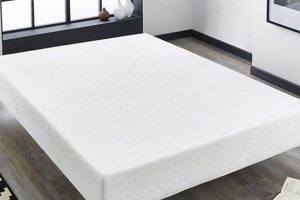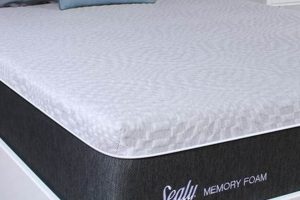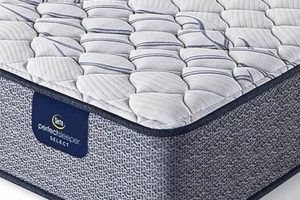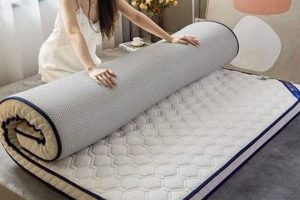The duration required for a memory foam mattress to reach its full intended size after being unpacked is a critical factor for consumers. This expansion period allows the compressed foam material to decompress and regain its original shape and density, ensuring optimal comfort and support. Several variables influence this process, impacting the time required for complete restoration.
Proper mattress expansion is important for experiencing the intended benefits of memory foam, including pressure relief and spinal alignment. A fully expanded mattress provides the correct level of support, contributing to better sleep quality and potentially reducing body aches. The development of compression technology for mattress shipping has made these products more accessible; however, understanding the expansion timeline is essential for customer satisfaction.
The primary factors affecting the expansion timeframe include the mattress’s density, the ambient temperature, and the length of time it remained compressed. These elements dictate how quickly the foam cells recover and influence the ultimate comfort and performance of the mattress.
Tips for Optimal Mattress Expansion
Ensuring proper expansion is crucial for realizing the full benefits of a memory foam mattress. Adhering to the following guidelines can help optimize the expansion process and improve sleep quality.
Tip 1: Unpack Promptly: Remove the mattress from its packaging as soon as possible after delivery. Prolonged compression can hinder the expansion process and may affect the mattress’s overall shape and feel.
Tip 2: Provide Adequate Ventilation: Ensure the room where the mattress is expanding is well-ventilated. This facilitates the release of any trapped odors and encourages quicker foam recovery.
Tip 3: Maintain Room Temperature: Memory foam responds to temperature. Warmer environments generally promote faster expansion. Aim for a room temperature between 68-72F (20-22C) during the expansion phase.
Tip 4: Allow Sufficient Time: While some mattresses expand within 24 hours, allow at least 48-72 hours for full expansion. High-density foams or mattresses that have been compressed for extended periods may require more time.
Tip 5: Rotate and Flip (If Applicable): Some mattresses benefit from being rotated or flipped (if designed to be flipped) during the expansion process. This can help ensure even expansion and prevent localized compression.
Tip 6: Avoid Immediate Use: Refrain from sleeping on the mattress until it is fully expanded. This allows the foam to properly decompress and provide the intended support and comfort.
Following these tips will help maximize the lifespan and comfort of your memory foam mattress. Complete expansion ensures the mattress delivers the support and pressure relief expected for optimal sleep.
These considerations are essential for maximizing the value and longevity of the investment.
1. Foam Density
Foam density is a primary determinant of the expansion duration for a memory foam mattress. The material’s density, measured in pounds per cubic foot (lbs/ft), directly influences the speed at which the mattress regains its original form after compression.
- Higher Density Foams
Foams with higher densities contain more material packed into the same volume, resulting in a tighter cell structure. This increased density makes it more difficult for the compressed foam to expand, leading to a longer recovery time. High-density mattresses, often associated with enhanced durability and support, can take several days to fully expand.
- Lower Density Foams
Conversely, lower density foams have more air and less material per cubic foot. Their open cell structure allows for quicker decompression and expansion. Mattresses made with lower density foams typically expand within 24 to 48 hours.
- Temperature Sensitivity
Density affects how the foam responds to temperature changes during expansion. High-density foams, due to their compact structure, require a warmer environment to facilitate quicker expansion, as heat softens the material. Lower density foams are less sensitive to temperature variations.
- Long-Term Performance Implications
While higher density foams take longer to expand initially, they generally offer better long-term performance in terms of support and resistance to body impressions. However, if a high-density mattress is not given sufficient time to fully expand, it may not provide the intended support and comfort, potentially impacting its lifespan.
The selection of a mattress density should consider the anticipated expansion period and the environment in which the mattress will be placed. Properly accounting for foam density ensures the user experiences the full benefits of the memory foam, including optimal support and pressure relief.
2. Ambient Temperature
Ambient temperature plays a critical role in the expansion process of a memory foam mattress. The viscoelastic properties of memory foam are temperature-sensitive, meaning that the material’s firmness and elasticity fluctuate in response to temperature variations. Lower temperatures cause the foam to become firmer and less pliable, thereby hindering its ability to expand fully and rapidly. Conversely, higher temperatures soften the foam, facilitating its decompression and return to its original shape. Therefore, a cold environment will significantly prolong the amount of time needed for complete expansion.
For example, a memory foam mattress unpacked in a room maintained at 60 degrees Fahrenheit may require considerably longer to expand potentially exceeding 72 hours compared to an identical mattress unpacked in a room at 75 degrees Fahrenheit. This difference in expansion time is due to the increased molecular mobility within the foam at higher temperatures, which allows the compressed cells to regain their original volume more efficiently. The practical significance of this relationship is that consumers should ensure the unpacking and expansion process occur in a climate-controlled environment with a temperature range conducive to optimal foam recovery.
In conclusion, ambient temperature is a key environmental factor that directly impacts the expansion rate of memory foam mattresses. Maintaining an appropriate temperature during unpacking and initial use is crucial to ensure the mattress achieves its intended size, density, and performance characteristics, leading to enhanced sleep quality and satisfaction. Failure to consider this element can result in a prolonged expansion period and potentially compromise the long-term comfort and support of the mattress.
3. Comp
ression Duration
The length of time a memory foam mattress remains compressed for shipping significantly affects its subsequent expansion timeframe. Prolonged compression can impact the foam’s structural integrity, influencing how readily it returns to its original form.
- Impact on Foam Cell Structure
Extended compression can lead to deformation of the foam’s cellular structure. The longer the mattress is compressed, the more the foam cells are subjected to sustained pressure. This pressure can weaken the cell walls, making it more difficult for the cells to rebound fully. Consequently, mattresses compressed for longer durations may take more time to expand and may not achieve their intended density or firmness.
- Release of Volatile Organic Compounds (VOCs)
Compression duration can also affect the release of VOCs from the foam. While most modern memory foam mattresses undergo processes to minimize VOC emissions, prolonged compression can trap these compounds within the foam. Upon unpacking, the mattress may require additional time to off-gas completely, affecting not only the expansion timeframe but also potentially impacting indoor air quality.
- Influence of Packaging Materials
The materials used in the mattress packaging during compression can further influence the expansion process. If the packaging restricts airflow or contains chemicals that interact with the foam, it can hinder the mattress’s ability to expand uniformly. Extended compression in inadequate packaging can exacerbate these issues.
- Reversibility of Compression Effects
While some effects of compression are reversible, prolonged compression can lead to irreversible changes in the foam’s physical properties. Mattresses compressed for excessively long periods might never fully regain their original dimensions or support characteristics, even after an extended expansion period. This can result in a compromised sleeping experience and reduced mattress lifespan.
In summary, the duration of compression is a critical factor governing the expansion process of memory foam mattresses. Shorter compression periods generally result in faster and more complete expansion, while prolonged compression can lead to structural deformation, increased VOC emissions, and potentially irreversible damage to the foam’s integrity, all of which directly influence the time it takes for the mattress to fully expand.
4. Ventilation levels
Ventilation levels within the environment where a memory foam mattress is expanding directly influence the duration required for the process to complete. Adequate ventilation facilitates the exchange of air around the mattress, aiding in the dissipation of volatile organic compounds (VOCs) and moisture that may be trapped within the compressed foam. Insufficient airflow can lead to a build-up of these compounds, potentially prolonging the time needed for the mattress to fully expand and off-gas. A real-world example of this is observing two identical mattresses unpacked simultaneously; one in a poorly ventilated storage room and the other in a well-ventilated bedroom. The mattress in the storage room will likely take longer to expand due to the higher concentration of trapped gases hindering full decompression.
Furthermore, ventilation contributes to temperature regulation around the mattress during expansion. While temperature itself is a factor, stagnant air can create localized temperature variations that impede uniform expansion. Sufficient airflow ensures a more consistent temperature distribution across the mattress surface, promoting even decompression of the foam cells. For instance, a mattress placed near a window with open airflow on a temperate day will often expand more evenly and quickly than one situated in a closed-off room, where temperature gradients are more pronounced. The practical significance lies in choosing a suitable location for unpacking, prioritizing rooms with windows or access to circulating air to expedite the expansion timeline.
In conclusion, proper ventilation serves as a critical, yet often overlooked, component in determining how quickly a memory foam mattress achieves its intended dimensions. By promoting air circulation and temperature consistency, adequate ventilation enhances the expansion process and the dissipation of residual gases, ultimately contributing to the mattress’s overall performance and user satisfaction. Neglecting ventilation can prolong expansion and potentially compromise the mattress’s initial comfort and support characteristics.
5. Mattress thickness
The thickness of a memory foam mattress directly influences the duration required for complete expansion. A thicker mattress, possessing a greater volume of compressed foam, necessitates a longer period for all internal layers to fully decompress and reach their intended form. The relationship is primarily driven by the increased mass that needs to expand against the constraints imposed by the packaging and the surrounding environment. A thin mattress, conversely, benefits from a reduced volume and can expand more rapidly, typically within 24-48 hours.
Consider a 10-inch memory foam mattress compared to a 14-inch model. The 14-inch mattress contains approximately 40% more foam. This increased material density requires proportionally more time for the entire structure to overcome compression and fully expand. Furthermore, the inner layers of a thicker mattress may experience reduced airflow compared to the outer layers, impeding the rate of expansion. The practical implication is that consumers should factor mattress thickness into their expectations regarding expansion time, allotting sufficient time based on the mattress’s dimensions to ensure optimal performance and comfort.
In summary, mattress thickness is a significant determinant of the expansion timeframe. Thicker mattresses require longer expansion periods due to increased volume and potentially reduced airflow to internal layers. Consumers are advised to acknowledge this correlation and allow ample time for complete expansion to achieve the intended comfort and support characteristics. Understanding this connection prevents premature use and ensures the full realization of the investment in the memory foam mattress.
6. Foam composition
Foam composition is a primary factor influencing the time required for a memory foam mattress to fully expand. The type of materials used, their density, and their arrangement all play a role in determining how quickly the compressed mattress regains its intended shape and firmness.
- Conventional Memory Foam
Conventional memory foam, typically made from polyurethane with added chemicals to increase viscosity and density, exhibits a slower expansion rate compared to some newer formulations. Its dense, closed-cell structure restricts airflow, hindering rapid decompression. As a result
, mattresses made primarily from conventional memory foam often require upwards of 72 hours for full expansion. An example is a budget-friendly mattress that remains noticeably compressed for several days after unpacking, indicating its primary composition is conventional memory foam. This delay can impact consumer satisfaction if not properly communicated. - Gel-Infused Memory Foam
Gel-infused memory foam incorporates gel particles or layers intended to improve temperature regulation and airflow. While the presence of gel may subtly impact expansion time, its primary effect is on thermal properties rather than significantly accelerating decompression. These mattresses may still require a similar expansion period to conventional memory foam, although some formulations designed for enhanced breathability might show marginal improvements. For instance, a mattress marketed for its cooling properties expands similarly to a non-gel version, demonstrating the gel’s limited influence on decompression speed.
- Plant-Based Memory Foam
Plant-based, or bio-based, memory foam replaces a portion of the petroleum-based polyurethane with plant-derived oils. This substitution can result in a slightly more open-cell structure, potentially facilitating faster expansion. However, the degree of influence depends on the percentage of plant-based content and the specific processing techniques used. Mattresses with a significant proportion of plant-based foam may exhibit marginally quicker expansion, though this benefit may be offset by other factors such as density and compression duration. A mattress with a high percentage of plant-based foam could expand within 48 hours, compared to the 72 hours needed for conventional foam, demonstrating its quicker rebound properties.
- Latex Hybrid Foams
While not strictly memory foam, latex hybrid mattresses often incorporate memory foam layers in combination with latex foam. The inclusion of latex, known for its resilience and rapid recovery, can indirectly affect the overall expansion profile. Latex’s quick response can help support and promote decompression of adjacent memory foam layers. A hybrid mattress, with a top layer of latex, may show a faster initial expansion compared to a full memory foam mattress, indicating how the integration of different foam types can influence the overall expansion process.
In conclusion, the specific foam composition profoundly influences the expansion time of a memory foam mattress. The presence of conventional materials, gel infusions, plant-based components, or latex hybrids each contribute uniquely to the decompression process. Understanding the interplay between these materials and their impact on expansion rates is crucial for manufacturers to accurately communicate expectations to consumers and for consumers to make informed purchasing decisions. The choice of foam impacts how long does it take memory foam mattress to expand, and consequently affects user satisfaction.
7. Manufacturing process
The manufacturing process of a memory foam mattress significantly influences its expansion timeframe after compression. Techniques employed during foam production, curing, and subsequent compression for shipping directly impact the material’s ability to regain its original shape and volume. Variations in these processes can lead to differing expansion rates, affecting consumer experience and product performance. For instance, a mattress manufactured with inconsistent cell structure due to inadequate mixing of raw materials may exhibit uneven expansion, resulting in prolonged decompression in certain areas. Similarly, mattresses subjected to excessive heat during curing can experience structural changes that impede their ability to fully rebound after compression. This is a critical component of how long does it take memory foam mattress to expand
The compression method also plays a vital role. Mattresses compressed using uniform pressure across the entire surface tend to expand more evenly and quickly compared to those compressed unevenly. Improper compression can cause localized deformation, requiring additional time for the affected areas to fully recover. Consider the difference between a mattress compressed using advanced rolling and folding machinery versus one manually folded and compressed using rudimentary equipment. The former is more likely to maintain its structural integrity, leading to a shorter and more predictable expansion period. A practical application of this understanding involves manufacturers optimizing their compression processes to minimize cellular damage and facilitate faster expansion, ultimately improving customer satisfaction and reducing return rates. Manufacturers should therefore always consider how long does it take memory foam mattress to expand during this part of the production.
In conclusion, the manufacturing process constitutes a critical factor in determining the expansion time of memory foam mattresses. From foam production and curing to compression and packaging, each step contributes to the final product’s ability to decompress effectively. Addressing manufacturing inconsistencies and optimizing compression techniques are essential for minimizing expansion times and ensuring consistent product performance. These improvements allow how long does it take memory foam mattress to expand to be a selling point instead of a point of concern. This proactive approach not only enhances customer satisfaction but also minimizes potential issues related to product quality and returns.
Frequently Asked Questions
The following addresses common inquiries regarding the timeframe for a memory foam mattress to reach its full dimensions after unboxing. These answers aim to provide clarity on factors influencing this process and offer guidance for optimal mattress preparation.
Question 1: What is the average duration for a memory foam mattress to fully expand?
Most memory foam mattresses require between 24 and 72 hours to fully expand. However, certain factors such as foam density, room temperature, and compression duration can extend this timeframe.
Question 2: Can a mattress be slept on before it is fully expanded?
While it is possible, it is not recommended. Sleeping on a partially expanded mattress may compromise its intended support and comfort characteristics, potentially affecting spinal alignment and pressure relief.
Question 3: Does temperature affect mattress expansion?
Yes. Lower temperatures can slow the expansion process, while warmer temperatures facilitate quicker decompression. Maintaining a room temperature between 68-72F (20-22C) is generally recommended.
Question 4: What can be done to expedite the mattress expansion process?
Ensuring adequate ventilation, maintaining a suitable room temperature, and promptly removing the mattress from its packaging can help accelerate expansion.
Question 5: Is uneven expansion a cause for concern?
Minor unevenness is common during the initial expansion phase. However, significant discrepancies that persist after 72 hours may indicate a manufacturing defect and warrant contacting the retailer or manufacturer.
Question 6: Does the mattress warranty cover expansion issues?
Warranty coverage for expansion issues varies depending on the manufacturer and specific terms outlined in the warranty agreement. It is advisable to review the warranty details to understand the extent of coverage.
Proper expansion is critical
for experiencing the designed benefits of a memory foam mattress. Adhering to recommended practices ensures optimal comfort and long-term performance.
The following section will detail essential tips for ensuring proper mattress maintenance.
Conclusion
Determining how long does it take memory foam mattress to expand is a multifactorial assessment, governed by foam density, ambient temperature, compression duration, ventilation, mattress thickness, composition, and the manufacturing process. Comprehending these variables enables informed consumer expectations and proactive management of the expansion phase, optimizing the mattress’s performance.
The expansion timeframe is not merely a matter of convenience; it directly impacts the support, comfort, and longevity of the mattress. Proper allowance for complete expansion represents a necessary investment to realize the full potential and therapeutic benefits afforded by memory foam technology. Prioritizing attention to these factors will ensure better sleep and overall satisfaction.







